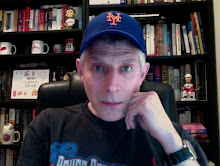"I DON'T LIKE MONDAYS" was one fucked up piece of pop music. A bouncy 1979 ditty inspired by the true story of a teen-aged girl who opened fire on a San Diego school yard, killing two people and wounding nine just 'cause, its off-kilter sentiments have not aged well.
But a shot at redemption for its co-author, Bob Geldof of the Boomtown Rats, came just five years later in the form of perhaps the most impactful holiday song since Irving Berlin wrote White Christmas in 1942.
 |
| The sleeve for the Columbia Records single |
Recorded by some of the biggest stars of the era in U.K. and Irish pop under the moniker Band Aid and carried to the world by MTV at the peak of its influence, Do They Know It's Christmas reverberates to this day.
In their three-minute and fifty-second tune, Geldof and co-author Midge Ure of Ultravox shamed the Euro-American world for living in relative safety, security and plenty while those on the horn of Africa were starving to death, then urged people to open their hearts and their wallets to help.
Among those belting out their trenchant message were Sting, Bono, Phil Collins, Culture Club's Boy George, George Michael, Bananarama, Paul Young, Jody Watley, Duran Duran and Spandau Ballet. In artfully pieced together solos, duets, trios and quartets they sang:
... But say a prayer, pray for the other ones... At Christmastime it's hard, but when you're having fun... There's a world outside your window, and it's a world of dread and fear... Where the only water flowing, is the bitter sting of tears... And the Christmas bells that ring there are the clanging chimes of doom... Well tonight thank God it's them instead of you!
Then, pivoting to the thesis question:
And there won't be snow in Africa this Christmastime... The greatest gift they'll get this year is life... Where nothing ever grows... No rain nor rivers flow... Do they know it's Christmas time at all?
The obvious answer was yes, yes they knew it was Christmastime. Christianity had come to Ethiopia 1,600 years earlier, making it one of the oldest Christian nations on earth. Africa as a whole, was and is heavily -- even if not predominantly -- Christian. That didn't stop critics from calling the sentiment Eurocentric and condescending.
Whether it felt like Christmas time was the issue. Yuletide greetings and neatly wrapped gifts all seem rather beside the point when there's nothing to eat at all, which lead to the point carried home by the ensemble chorus:
Feed the world! Let them know it's Christmas time again... Feed the world! Let them know it's Christmas time again... Feed the World! Let them know it's Christmas time again...
 |
A side/B side |
Feed the world! Let them know it's Christmas time again... Feed the world! Let them know it's Christmas time again... Feed the World! Let them know it's Christmas time again...
We Are the World, an American counterpart single was recorded in 1985 by Michael Jackson, Bruce Springsteen, Lionel Richie and other big stars who wrapped it in an LP's worth of material under the banner USA for Africa. Then came the trans-Atlantic benefit concert, Live Aid. Surely all of that frenetic activity could contribute something positive.
 |
| Foreign aid at 45 rpm |
And that's been a subject of some dispute.
While all this was going on, Ethiopia was ruled by a Soviet-backed dictator, Mengistu Haile Mariam. The famine, which killed an estimated 1.2 million people, happened on his watch and -- according to Human Rights Watch -- as a result of his policies, while the government he led fended off an insurgency.
While all this was going on, Ethiopia was ruled by a Soviet-backed dictator, Mengistu Haile Mariam. The famine, which killed an estimated 1.2 million people, happened on his watch and -- according to Human Rights Watch -- as a result of his policies, while the government he led fended off an insurgency.
Much of the money raised through all these efforts went not for food, but for weapons, according to a 1986 Spin Magazine expose. Over the ensuing four decades, Geldof has vehemently disputed this was the case.
While the cloud over his efforts and those of Ure and the performing artists has never truly dissipated, the song has endured, being remade in 1989, 2004 and yet again in 2014, the last time in service of raising money to combat an outbreak of the deadly Ebola virus.
Still, there was no time like that first time, 35 years ago this month.
Still, there was no time like that first time, 35 years ago this month.
-- Follow me on Twitter @paperboyarchive
































